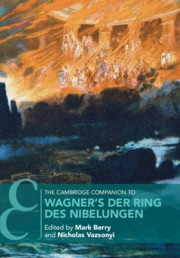Book contents
- The Cambridge Companion to Wagner’s Der Ring des Nibelungen
- Cambridge Companions to Music
- The Cambridge Companion to Wagner’s Der Ring des Nibelungen
- Copyright page
- Contents
- Figures
- Music Examples
- Contributors
- Preface
- Abbreviations
- Introduction
- Part I Myth
- Part II Aesthetics
- Part III Interpretations
- Part IV Impact
- 11 Critical Responses
- 12 Placing the Ring in Literary History
- 13 Specters of Nazism
- 14 The Ring in Cinematic and Popular Culture
- 15 Notable Productions
- Bibliography
- Index
12 - Placing the Ring in Literary History
from Part IV - Impact
Published online by Cambridge University Press: 18 September 2020
- The Cambridge Companion to Wagner’s Der Ring des Nibelungen
- Cambridge Companions to Music
- The Cambridge Companion to Wagner’s Der Ring des Nibelungen
- Copyright page
- Contents
- Figures
- Music Examples
- Contributors
- Preface
- Abbreviations
- Introduction
- Part I Myth
- Part II Aesthetics
- Part III Interpretations
- Part IV Impact
- 11 Critical Responses
- 12 Placing the Ring in Literary History
- 13 Specters of Nazism
- 14 The Ring in Cinematic and Popular Culture
- 15 Notable Productions
- Bibliography
- Index
Summary
In 1852, Wagner described his text for the Ring cycle as “the greatest poem that has ever been written.” This chapter asks to what extent the musical innovations – responding to historical linguistics – were formative for a generation of writers as well as composers. To what extent did innovation in one medium engender innovative techniques in another? After contextualizing Wagner’s operatic reforms within his early writings and related moments within the history of the genre, it explores a cornucopia of modernist writers working in the shadow of the Ring cycle: from Wilde, D. H. Lawrence, and Aubrey Beardsley, to Yeats, Mann, and Beckett; from Mallarmé and Dujardin to Zola and Proust, to name but a few. It traces the profound influence on literature of leifmotivic techniques, as “carriers of feeling,” amid the shift to words as a dereferentialized system of signs. The role of alliteration, direct parody, interior monologue, and involuntary memory all contribute to the overall view that appropriation and influence of “reformist” techniques in literature and linguistics remained in the hands of authors, regardless of Wagner’s predictions for his own literary greatness.
- Type
- Chapter
- Information
- The Cambridge Companion to Wagner's Der Ring des Nibelungen , pp. 269 - 296Publisher: Cambridge University PressPrint publication year: 2020
- 1
- Cited by



